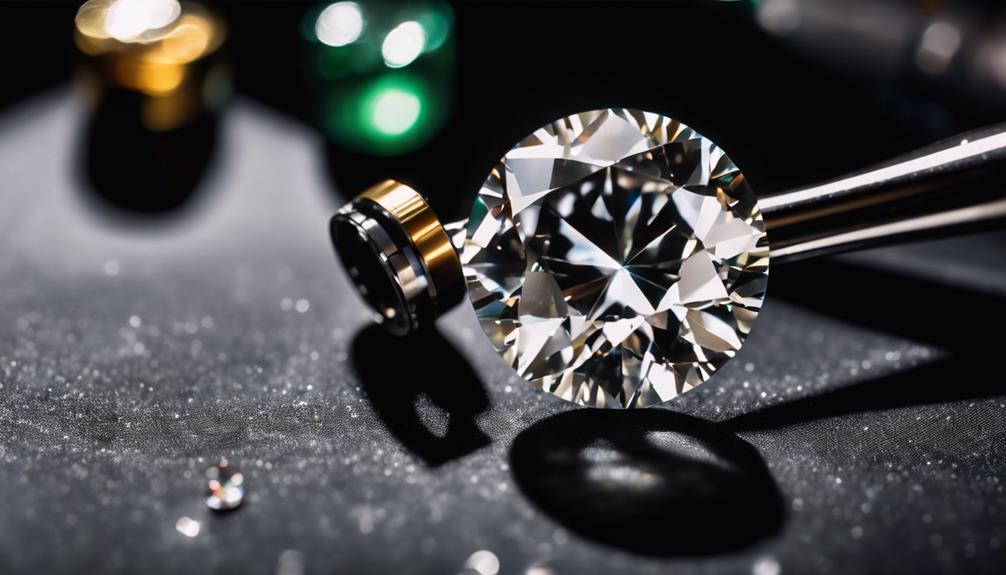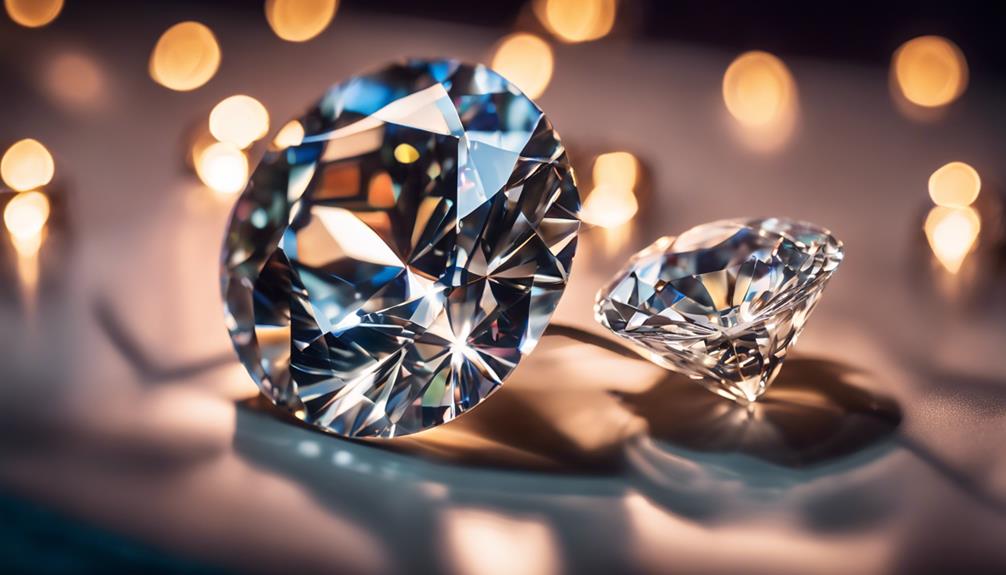Choosing a G color diamond gives you a near-colorless gem that balances beauty and value. Just a step below the highest grades, you’ll barely notice any color difference. These diamonds are 10-25% cheaper than D or E grades, making them an excellent choice for budget-conscious buyers who don’t want to compromise on brilliance. White gold or platinum settings can enhance their appearance even more. Prioritize the cut quality and always opt for GIA certification for assurance. To truly maximize your investment and understand how G color diamonds stand out, there’s more you can explore about them.
What Are G Color Diamonds

G color diamonds are near-colorless gems that sit just below the colorless range on the GIA grading scale. When you’re looking for the perfect diamond, understanding diamond color grading is essential. G color diamonds fall in the near-colorless range, positioned right after D, E, and F grades, which are considered colorless.
You might wonder why G color diamonds are so popular. It’s because they offer an excellent value for your budget. These diamonds are typically priced 10-25% lower than D and E color diamonds but still maintain a beautiful, white appearance. The slight warmth in G color diamonds is virtually undetectable to the untrained eye, making them an attractive option for many buyers.
When choosing an engagement ring, G color diamonds are a superb choice. They fit well in various metal settings, especially platinum and white gold, complementing their near-colorless sparkle. Additionally, they’re ideal for larger diamond shapes where even slight color differences can be more noticeable.
Comparing G Color to Other Grades
When comparing G color diamonds to other grades, you’ll find that they offer a unique blend of value and visual appeal. Positioned at the top of the near-colorless category on the diamond color scale, G color diamonds strike a balance between quality and affordability.
Let’s look at how G color diamonds compare to others:
- Higher Color Grades (D, E, F): G color diamonds are just a step below these grades. They may have a minor yellow tint under magnification, but to the naked eye, they appear nearly as bright and white. The differences in color are minimal, but you’ll notice a significant price premium for D, E, and F diamonds, sometimes 10-25% higher.
- Similar Grades (H, I, J): When comparing G to H color diamonds, you’ll see that H diamonds exhibit a more noticeable faint yellow hue, especially under certain lighting conditions. As you go further down the diamond color scale to I and J, the yellow tint becomes increasingly prominent, making G color diamonds more desirable for their better appearance.
- Affordability: While this will be explored in the next subtopic, it’s crucial to recognize that G color diamonds provide excellent value, offering a high level of brilliance without the hefty price premium of higher color grades.
Affordability of G Color Diamonds

Why should you consider a G color diamond when looking for an affordable yet stunning option? G color diamonds strike an impressive balance between price and visual appeal, making them ideal for budget-conscious diamond buying.
While colorless diamonds (D, E, F) are highly sought after, they come with a hefty price tag. G color diamonds, on the other hand, are typically 10-25% more affordable than their colorless counterparts.
The affordability of G color diamonds doesn’t mean you’re compromising on beauty. These diamonds appear near-colorless to the naked eye, offering a high level of brilliance comparable to higher-grade stones. This means you can enjoy a visually stunning diamond without breaking the bank.
Additionally, the price difference between G and H color diamonds is significant, with G color diamonds providing better value while still maintaining that near-colorless appearance.
For an even more economical choice, consider lab-grown G color diamonds. These can be priced up to 50% less than natural diamonds, offering substantial savings.
Ultimately, G color diamonds maintain a stunning visual appeal, making them perfect for various settings, including engagement rings, while remaining budget-friendly.
Best Settings for G Color Diamonds
Selecting the perfect setting for your G color diamond can greatly enhance its near-colorless beauty and overall brilliance. Here are some of the best settings to take into account:
- White Gold or Platinum Settings: Opt for white gold or platinum settings to amplify the colorless appearance of your G color diamond. These metals reflect the diamond’s brilliance without introducing any unwanted yellowish tint, keeping your gemstone looking as colorless as possible.
- Halo Settings: Surround your G color diamond with a halo of smaller diamonds in the F to G color range. This setting not only boosts the overall sparkle but also creates a cohesive and visually stunning look. The surrounding stones enhance the main diamond’s brilliance, making it appear larger and more radiant.
- Side Stone and Pavé Settings: Incorporate side stones or a pavé band to maintain a balanced aesthetic and maximize the overall sparkle. These settings work well with G color diamonds, allowing the central stone to stand out while still complementing the smaller diamonds around it.
Buying Tips for G Color Diamonds

Prioritize GIA certification to guarantee your G color diamond is accurately graded and of high quality.
When shopping for G color diamonds, always inspect the cut quality first. A superior cut can greatly enhance the diamond’s brilliance and effectively mask any subtle color differences. This makes G color diamonds appear nearly colorless, maximizing their visual appeal.
One of the key benefits of choosing G color diamonds is the price advantage they offer. Compared to higher color grades like D, E, or F, G color diamonds can be 10-25% more affordable. This allows you to get a beautiful diamond without breaking the bank.
Additionally, consider the diamond’s setting. Opt for platinum or white gold settings to enhance the near-colorless look of G color diamonds. These metals reflect light beautifully and complement the diamond’s natural brilliance.
Don’t forget to inspect your G color diamond under various lighting conditions. Bright lighting can reveal subtle color variations that aren’t visible in dimmer settings.
Conclusion
To sum up, opting for a G color diamond means you’re getting exceptional beauty and value.
By understanding its near-colorless quality, you can confidently compare it to other grades and appreciate its affordability.
Choosing the right setting will enhance its brilliance, making it a standout piece.
Remember, informed buying tips help you make the best choice.
So, go ahead and invest in a G color diamond—you’ll enjoy both its sparkle and the smart investment you’ve made.



